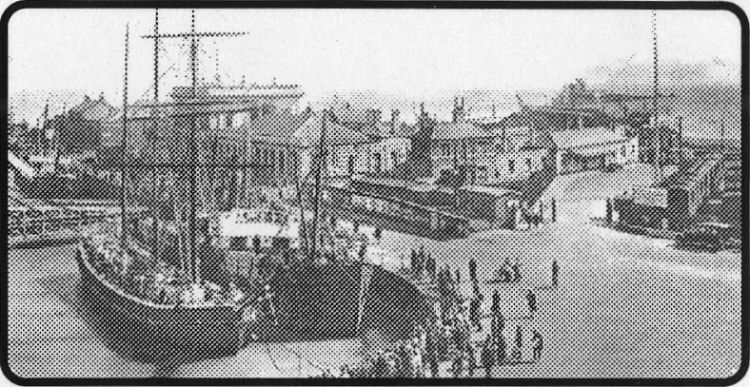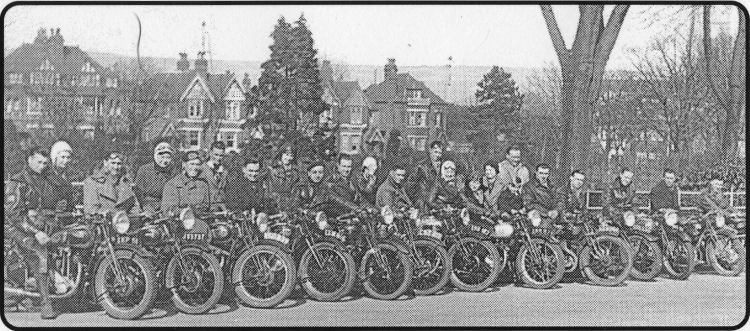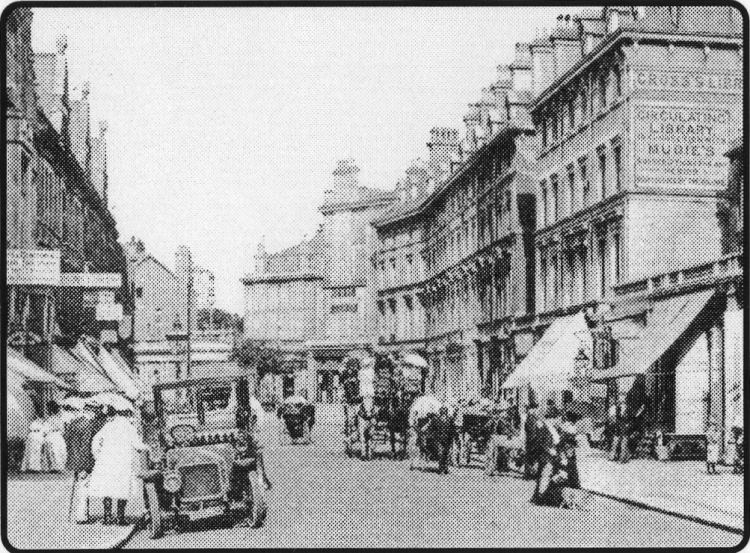
Published 5 October 2000
Country run
BERT Burgess, of Surrenden Road, Folkestone, showed me this interesting
photograph, right, of former Folkestone motorcycle club men and women with a
line-up of different makes of motorcycle, as they met for a regular club run
outside Kingsnorth Gardens more than 60 years ago.
Folkestone for a steak and kidney pie - costing only 6d (2.5p) he recalled -
at Charlie’s Pent Stream Wall cafe, near the harbour, and they might take in
a
A FINE picture of Sandgate Road, Folkestone, part of a postcard view
postmarked 1910. from Memories reader Peter Hooper, of Dover Road.
trip to the ‘flicks,’ sitting in the sixpenny (2.5p) seats with all their
motorcycle clobber.
Bert recalls the first two riders on the left were eventually married -
‘Asher’ Runacres and Betty Hickmott. Ninth In the line-up is Bob Lee, a
barber at one time near the Darlington Arch.
Number 12 is ‘Tonk’ Hickmott (brother of Betty), then 14th Betty Bigg,
married in 1940 to Bert Burgess, who is number 19, under the tree. Number 16
is Roy Collins, a boot repairer at Lyminge at one time. The tall man in a
light coat with a scarf was Samuels a local motorcycle agent; and last on
the right was Reg Gordon.
The club met at the White Horse public house, Hawkinge.
Bert was interested in the Park Farm picture in Memories recently because
his grandad, Bill Mills, who lived in Albion Road, used to work at nearby
Walton Manor Farm (Snape & Lesley’s) where he was in charge of the animal
feed. Bert went to school with the son Gerald Snape.
Bert’s father was Clarence
They invariably met on a Sunday and on this occasion, believed to be one day
in September 1937, they were off for a country run.
Often they would end up back in
FOLKESTONE Motor Cycle Club members in Kingsnorth Gardens. Folkestone, about
to set off on one of their regular runs into the country before the Second
World War.
Burgess, who used to work for Davis & Davis, the removals firm, while his
mother was Flo (nee Mills.) Bert was born in 1918 in their home at 88 Black
Bull Road.
He started work as an apprentice with Martin Walter as a motor mechanic,
later putting his training to good use during the Second World War when he
was called up into an Artillery Field Regiment, progressing to the Royal
Electrical & Mechanical Engineers, serving with a heavy workshop unit.
This followed the advanced units of the Allied Forces into France a few
weeks after D-Day. Bert went on to serve until April 1947.
He then spent 20 years abroad after joining the Kuwait Oil Company late in
1947, moving later to India with a company
which was part of the Anglo-Iranian Oil Co. and then worked in Pakistan on
staff recruitment.
His wife Betty (nee Bigg), who served in the ATS during the war, went out to
join him in Pakistan in 1948 and Janet, the second of their two daughters,
was bom in Lahore in 1949.
Betty, the daughter of Charles and Florence Bigg, was born in Royal Military
Avenue, Cheriton. Charles, a painter and decorator with S.J. Clark, was well
known in Cheriton as ‘Chum’ Bigg.
Transferred back to Kuwait Bert was given the job of setting up a training
centre to train the Bedouins to work in the oilfields.
Later, returning to England, he worked with the Industrial (Engineering)
Training Board and was asked to set up a group
training scheme for a group of companies in Maidstone.
He retired at 65 in 1983.
Bert and Betty’s first daughter, Janet, born in 1949, married Gerald Rockett,
the son of Sam Rockett, very well known in years gone by as the owner of the
Marina outdoor swimming pool.
The couple had a son Richard, who works as a roofing design engineer.
Daughter Jennifer's husband is Ian Tittle, son of Sidney Tittle, who owned
the Ambassador Hotel until he retired. The couple have three children. The
eldest is Ben, who is in banking in Calgary, where his father works for
Shell. Daughter Bernice is a paramedic in Saskatchewan, Canada, while
Lauren, who lives in Ascot, has just passed her A levels.



 |
|
1900
Wood-surface roads to cut down traffic noise!
>f Qfl/yTS DIFFICULT to credit it today, but a century ago local
councils sometimes paved streets with blocks of hardwood which helped to
lessen the noise of heavy traffic. And this was the Herald's solution to
some pretty deafening noise from motor traffic in Hytlie High Street.
The editor suggested that the councillor who could persuade the council
to lay down a little wood paving to solve the problem of noise would
soon be considered worthy of being honoured by putting up a statue. One
trader complained that it was necessary to suspend all conversation in
some shops while traffic passed by. To deal with a similar problem in
Sandgate Road, opposite Alexandra House, where well known businessman
Adolphus Davis, lay seriously ill in bed. tan (bark chippings?) was laid
down on the surface of the road. But Felix wrote that unfeeling
charabanc conductors persisted in blowing their 'discordant' horns. It
was a noise which seemed to grow worse every day, he complained. New
Superintendent of the local Methodist circuit, was the Revd Ralph Spoor,
who was given a big welcome. He succeeded the Revd George Adcock.
|
|
1925
Shock as RAF Hawkinge flier nose-dives to death.
•4 QO r MANY local people watched in horror as an experienced RAF pilot,
flying a bi-plane machine plunged out of control to his death, into a
ploughed field at the foot of Waterworks Hill. Folkestone. One
eyewitness told of being startled by the sound of a crack "as if
something had busted" another told of looking up and seeing that both
wings on one side were drooping and buckled up. From 100 ft up the
aircraft noso-dived into the ground 15 yards behind him. Another
eye-witness told how the plane was at about 2.500ft when something went
wrong. The flier was Lieutenant A.W. Cudden-Davis. of the 17th Squadron
RAF from Hawkinge. who was killed on his wedding anniversary, the
inquest was told. An officer from his unit told the coroner a structural
fault was thought to be to blame. Bournemouth Gardens resident C.H.
Stevens pressed the Town Council to include steps up the cliff at East
Cliff as part of the improvements being made there, saying it would
protect the cliffs from damage caused by young climbers. Dymchurch
bowler Mr M Upton set up a remarkable record in a match against
Folkestone Century Club. He took all 10 wickets, each player being clean
bowled. Pity the Herald writer didn't find out his Christian name, but
then it wasn't, it seems the done thing 75 years ago, although it was by
no means a hard and fast rule.
|
|
1950
“Mrs Brough” has first play at the Leas Pavilion.
•f Q C/\THE Evening Standard was advertising >L«/3V/in local papers a
special series, headed ~A Mid-Century Inquiry into Marriage and Morals"
claiming readers would find it an "arresting" feature. Its stated
purpose was to examine changing moral standards in relation to marriage
and divorce and the new personal and social problems facing married
couples in 1950. An obvious ploy to boost circulation. Lord Louis
Mountbatten travelled on the footplate of the Romney. Hythc and
Dymchurch Railway's steam locomotive Hurricane, when he accompanied Lord
and Lady Brabourne on a visit to the line. The ill-fated British
airliner Brabazon was due to fly over Folkestone and Hythe as over 70
aircraft took part in the Daily Express Round-the-Coast handicap race.
The Brabazon. flying from Hum airport, wasn't taking part in the actual
race. Ten years to the month after the battle the Herald recalled the
epic dog-fights over Kent in September 1940 when the Battle of Britain
reached its peak, the German Luftwaffe failing to gain superiority in
the air over the RAF. One of the Brough husband and wife partnership
behind, the Arthur Brough Players, who entertained for years in the Leas
Pavilion theatre, Elizabeth Addyman had her first play, Fortunes in a
Teacup, performed at the Leas.
|
|
1975
Torrents of rain flood area and swell the reservoirs.
•4 Q*» r A DELUGE of rain hit Shcpway 25 years ago. _L«7 I 9 enough,
estimated weather experts, to provide baths for every resident until the
year 2000! Well over 15 million tons of rain fell in a week causing
flooding. A little under two inches of rain - and weathermen said one
inch over an acre of land represented 100 tons of water! Council-backed
town guides looked likely to be phased out by 1977 as Shepway Council
looked into ways to cut costs. The idea was that each resort in the area
should go it alone and produce their own guides to attract tourists. A
name associated with cross-Channel ferry traffic for 60 years, the Maid
of Orleans made her last trip on the short sea route in September. She
was the last traditional passenger ferry to run on the short sea routes
from Folkestone and Dover. But she was no sluggard. The old lady was
capable of a nifty 22 knots. Three years earlier she had closed the
Golden Arrow service. Skipper for the last trip, Capt George Sutcliffe,
of Dover, was joined on the bridge by ex-masters Elgar Blaxland and Jim
Giddy. Great inventive pioneer in the field of transport. Thomas Aveling
began farming on his own account on Romney Marsh. Recognising the
potential of steam, in 1859 he took out a patent for a self-propelled
engine -a traction engine - he designed himself. His story was told in
Your Book of Traction Engines, by Alan Bloom, published in 1975 and
reviewed in the Herald's former ■‘Family Bookshelf" column. |
|




